- Home
- Encyclopedia
- Wyoming’s Long-lived Bucking Horse
Wyoming’s Long-lived Bucking Horse
Wyoming’s well-known bucking-horse-and-rider logo has changed many times since soldiers first used it on airplanes, arms and equipment in World War I France. Nor were all its versions modeled on the same real-life originals. At least three real-life horses and riders were associated with the logo as it evolved from its first appearance in 1918 until 1936, when the state appropriated the image for license plates and, as time went on, for other purposes as well.
Evolution of the idea
World War I veteran George N. Ostrom is credited with originating the emblem as a symbol of Wyoming when he was stationed in Bordeaux, France, in 1918. Ostrom admired his horse, Redwing, so much that he smuggled it from Sheridan, Wyo., all the way to France. When his commanding officers announced a contest for an emblem to represent individual regiments, Ostrom painted a picture on a drumhead of Redwing bucking with a cowboy on his back. The design won the contest and was painted on various types of gear and equipment, including Renault tractors for hauling guns, White brand trucks, road signs and even lapel buttons.
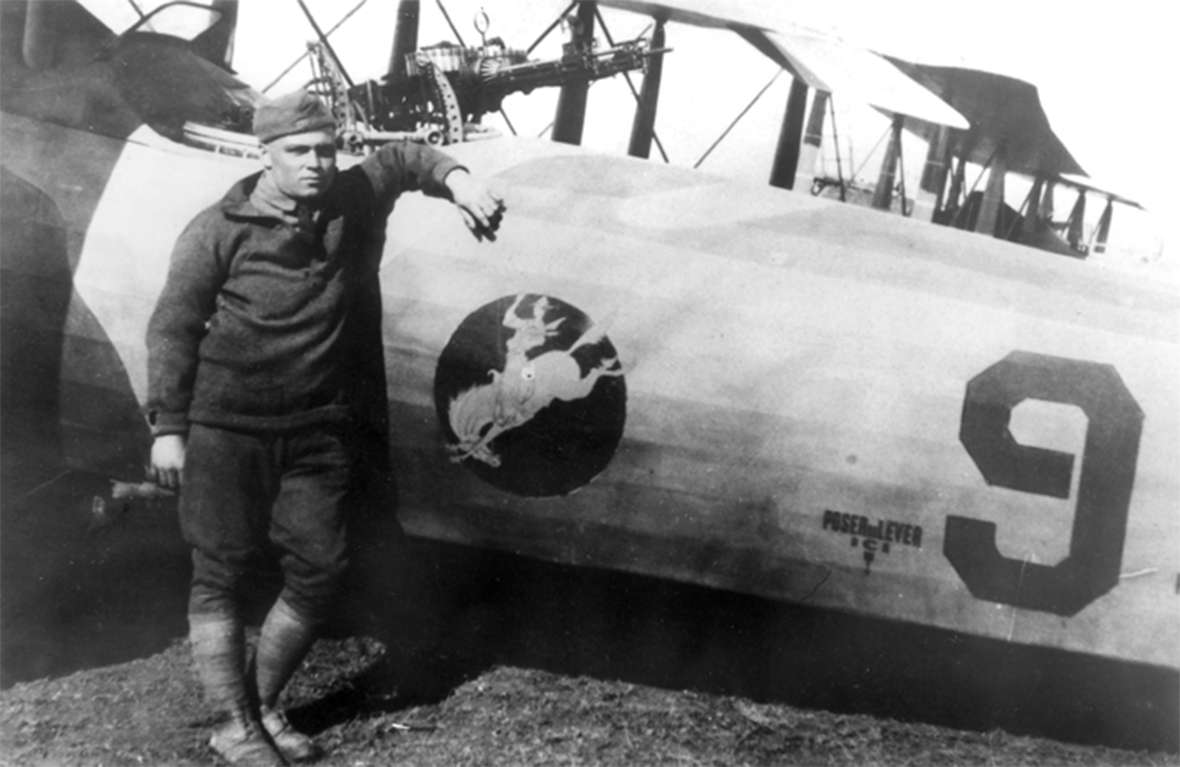
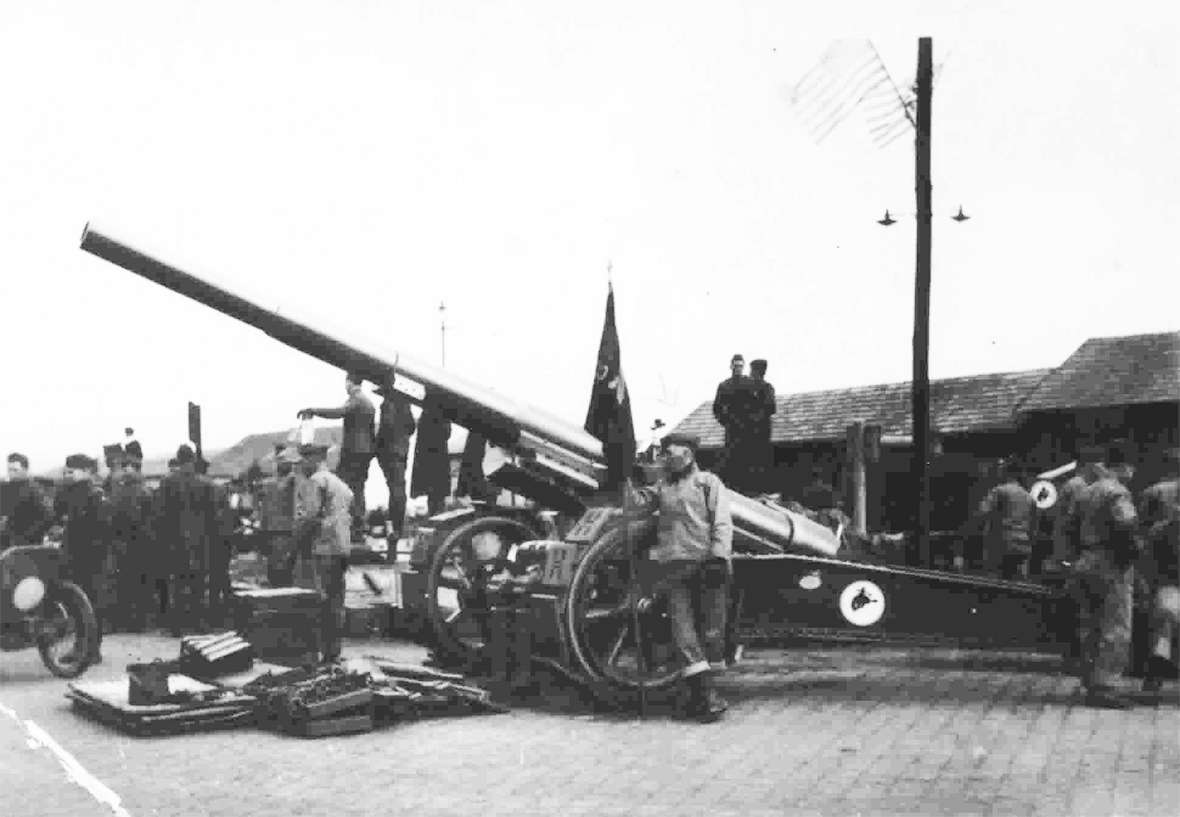
In about 1921, the University of Wyoming athletic department developed a bucking horse and rider insignia for its uniforms. This image was apparently not connected to Ostrom’s. Instead, its inspiration was Steamboat, a black gelding with three white stockings. He was named for the whistling sound of his breath, caused by a broken nose.
Steamboat had a reputation for wicked, violent bucking, swapping ends and twisting by kicking his fore and hind legs in two different directions. He was also known for “sunfishing,” in which a horse launches himself swiveling on a horizontal axis, aiming his belly away from the ground. Apparently, he always bucked when mounted, often landed stiff-legged and had unusual stamina. More than one cowboy called him a true outlaw. Very few rode him to a standstill.
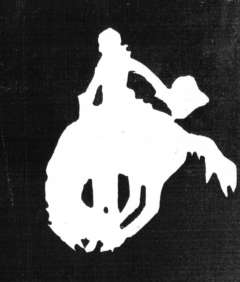
The familiar logo that now appears everywhere in Wyoming began with Secretary of State Lester Hunt in 1935, when automobile license plates were standardized and the legislature directed Hunt to develop a unique design. Hunt selected a drawing by Allen True, of Denver, who had painted the murals in the Wyoming House and Senate chambers nearly two decades earlier. In 1936 the logo was stamped on all license plates. It has been used ever since.
Controversy, contradictions, and complications
In 1918, were there two bucking-horse designs—and designers—or one? Wyoming resident Dewey H. Jones served in the U.S. Army’s air force in World War I and claimed “full credit for the Bucking Broncho” stenciled onto an airplane. Jones’s logo is so different from Ostrom’s that nobody could mistake one for the other: Although both show four legs, Jones’s horse is kicking his hind legs high into the air, while Ostrom’s horse is hunching his back, and all four feet are close together under his body. In addition, all the known World War I uses and spin-offs are modeled on Ostrom’s design except one airplane in an undated photo showing the logo Jones claimed was his.
After Allen True’s design became the official license plate logo, “it started quite a controversy among the returned soldiers,” Ostrom told Robert Helvey in a May 21, 1958, interview in Big Horn, Wyo. This interview is on file at the American Heritage Center at the University of Wyoming. “I began to get big mail,” Ostrom continued, “stating that the state had stolen our bucking bronco.”
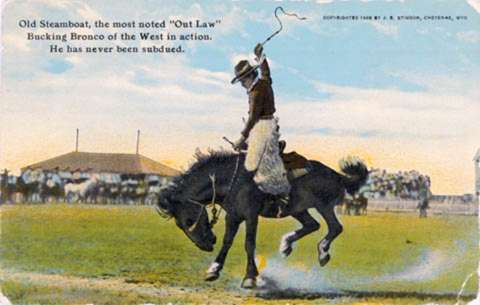
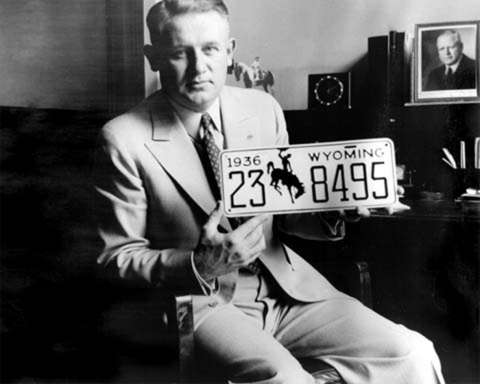
Ostrom asked Hunt sometime later to “give that bronco to the state of Wyoming in title and dedicate it in the shape of a memorial, through the legislature in memory of the [Wyoming] troops that had served in WWI. … This he said he definitely would not do; he had a copyright on my bronco; it was his and he could do what he pleased with it.”
Since True’s and Ostrom’s designs differ, Ostrom could only have meant that Hunt took the idea, not the literal image. True’s design, unlike Ostrom’s, shows only three of the horse’s legs; in addition, the back of True’s horse is not hunched. Both cowboys are waving their hats, but their arms are at different angles.
In a 1953 letter to Lola M. Homsher, Wyoming state archivist, Hunt wrote that his idea was “entirely original.” Hunt personally held the copyright for the license plate logo; in 1942, near the end of his second term as secretary of state, just before he became governor, he transferred it to the state of Wyoming, he wrote.
Ostrom’s account, however, implies that Hunt held the copyright longer than this , and that Hunt relinquished it to the state under pressure from Ostrom “as he approached his second term as governor.”
Horses and riders
Apparently, nobody has ever contested Redwing as the model or inspiration for Ostrom’s design. The rider is likely anonymous.
Equally, Steamboat has always been associated with the University of Wyoming insignia, especially the earliest versions. More than one cowboy has been mentioned as the rider, but most sources agree that both horse and rider were first modeled after a well-known photo of Guy Holt riding Steamboat at the Albany County Fair in 1903.
The identities of the license-plate horse and rider are less clear, but not because the historical record is ambiguous. Hunt stated that the horse was “no particular horse,” but that the rider was inspired by Lander cowboy and rodeo stunt rider Albert “Stub” Farlow.
Hunt, also from Lander, knew Farlow and admired his ability. Because Farlow’s name is connected with the license-plate logo, Deadman, a bucking horse he rode at least once, is sometimes also associated with the logo, but there is no other basis for this.
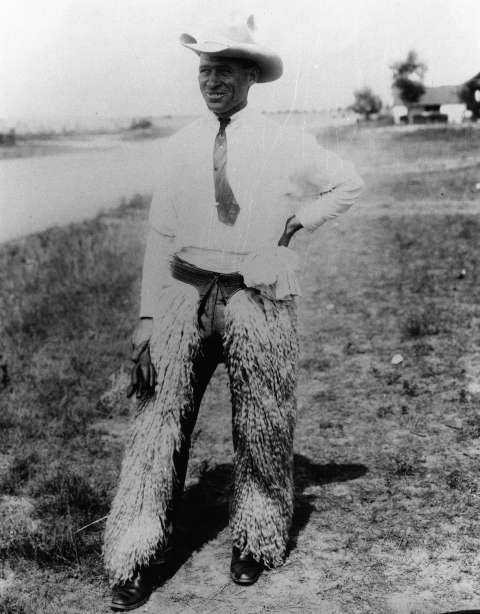
Steamboat, more than either Redwing or Deadman, seems to have captured the imagination of many Wyoming residents. Because he was stubborn, contrary and energetic, many feel that he represents the spirit of Wyoming.
Therefore, although the historical record shows that only the past and present University of Wyoming bucking-horse icon was inspired by Steamboat, many people associate the license plate logo with him as well. In turn, that logo, having superseded Ostrom’s and other early designs, is used almost exclusively to represent and advertise Wyoming. Therefore, by force of public perception, Steamboat has become the bucking horse symbol of Wyoming.
Military uses
Possibly during World War I, but more likely after, unofficial shoulder-sleeve insignias appeared, with Ostrom’s design. It was also stenciled onto helmets, but perhaps not during the war. In 1941, the Wyoming Army National Guard 41st Military Police Company at Fort Lewis in Washington state used this same image, or a close approximation of it, on a sign.
Ten years later, the 300th Armored Field Artillery Battalion (“Cowboy Cannoneers,” Wyoming Army National Guard) took a Wyoming Highway Department “Entering Wyoming” road sign with them to Korea. This sign has the license plate logo on it, and since then, Wyoming National Guard units have carried a similar sign when deployed to many major military operations.
Deirdre M. Forster, State Public Affairs Officer for the Wyoming Military Department, notes that “[e]very Wyoming Army National Guard unit that has deployed since Sept. 11, 2001, has taken an ‘Entering Wyoming’ highway sign with them. … The signs are created in house to replicate the one … from Korea.”
In addition, this logo has been stenciled onto National Guard buildings, restored airplanes and other equipment. Retired Col. Larry D. Barttelbort, military historian and expert on the military uses of the logo, reports two episodes in which True’s design was depicted with four legs. In 1953, when acting Gov. Clifford Joy “Doc” Rogers found the logo being stenciled onto a Wyoming Air National Guard F-80 fighter plane, he objected. So the graphic artist added another leg, thus creating an unofficial logo not owned by the state. In a 1986 painting, “Cowboy Artillery At Soyang,” artist Mort Kunstler depicted a famous battle in the Korean War, mistakenly showing a four-legged horse on a sign, a helmet and an M-7 105 mm self-propelled Howitzer. It is unknown whether the artist was responsible for the mistake, or was wrongly advised.
More surprising and potentially confusing yet, in the 1970s, George Ostrom used a horse and rider logo that resembles the modern version much more than it does his own. Ostrom was guest speaker at a graduation ceremony for non-commissioned officers at the Wyoming National Guard’s Camp Guernsey Joint Training Center in Platte County, Wyoming.
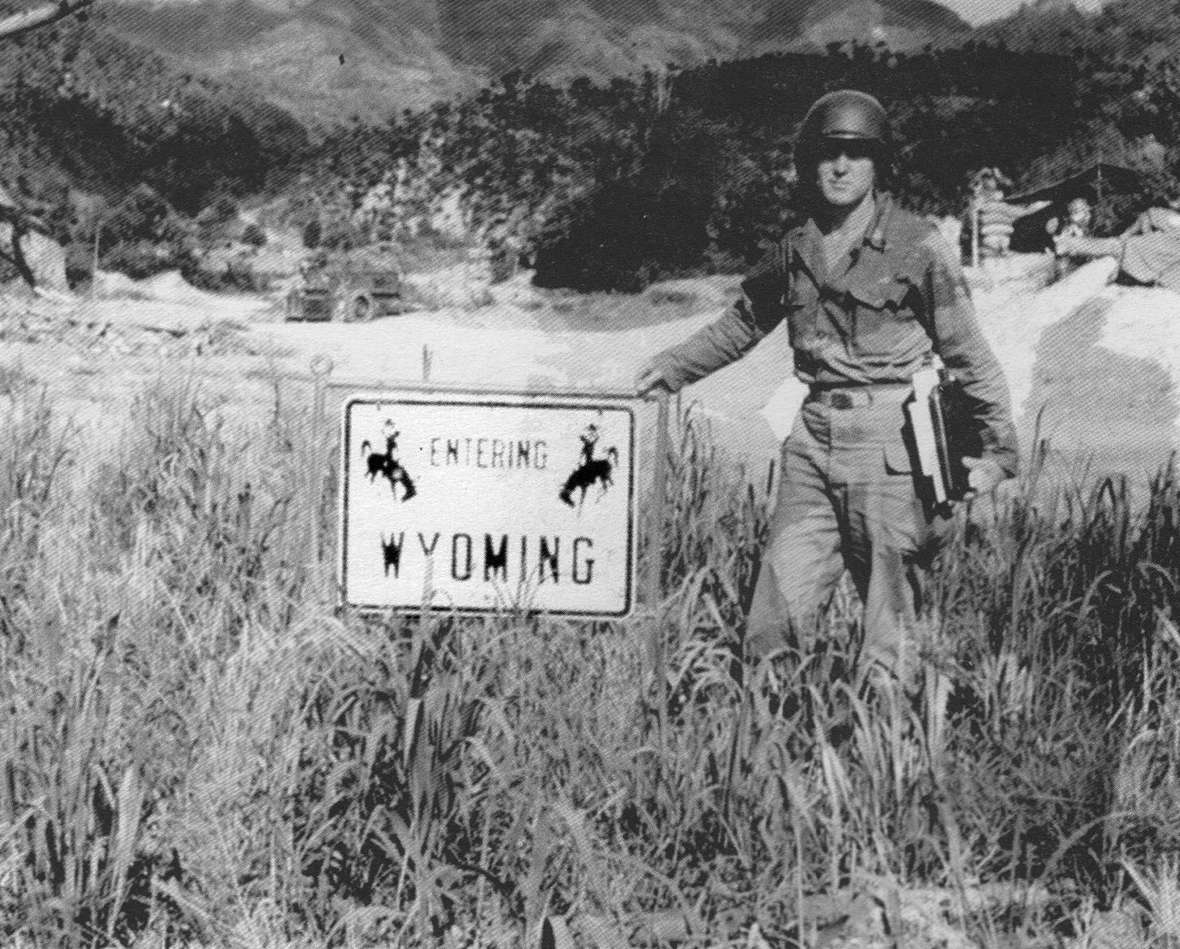
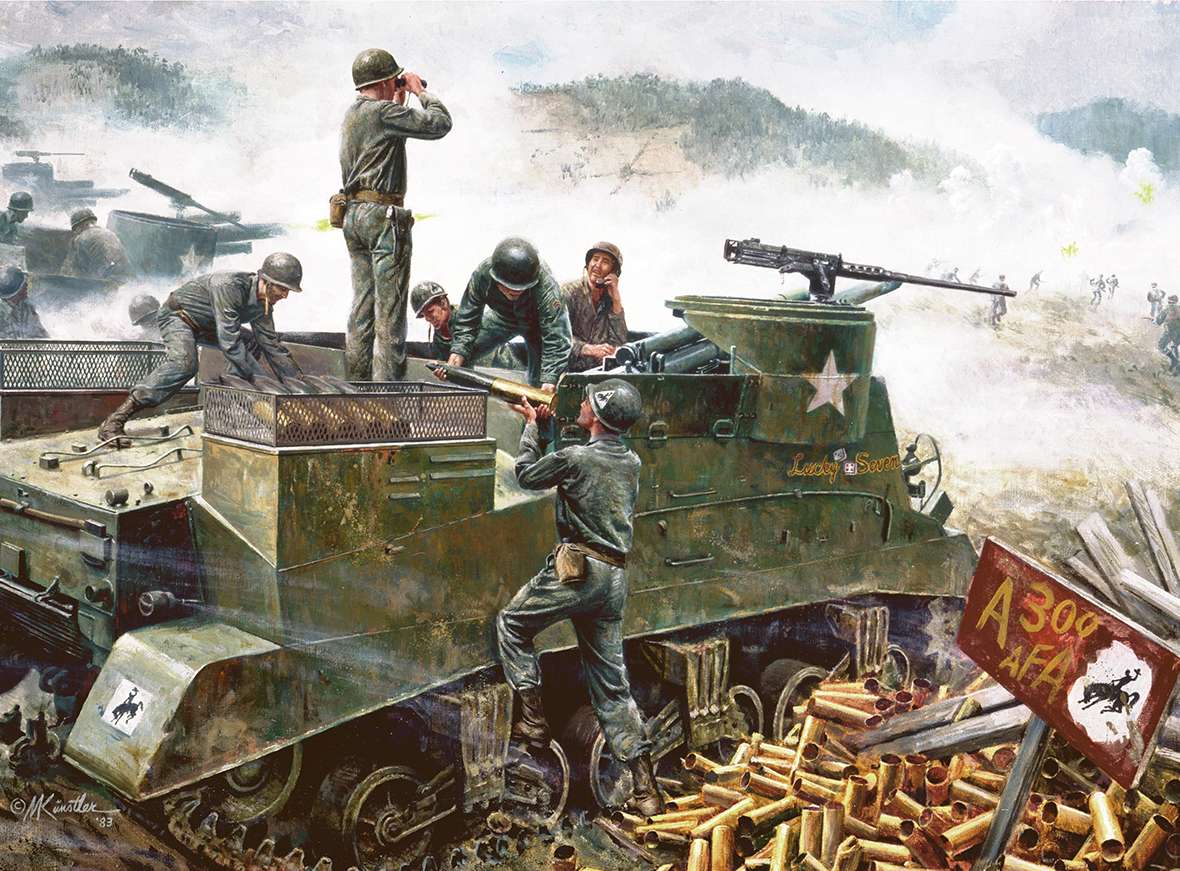
Commercial and other uses
Right after World War I, German manufacturers began producing humidors (cigar containers) and beer steins with Ostrom’s design on them. According to Barttelbort, this was “the first commercial use of a Wyoming bucking horse and rider logo.”
Lester Hunt discovered that many people outside of Wyoming wanted the license plate logo. When the plates were first issued, highway patrolmen in California reported a high incidence of plates stolen from Wyoming cars. Residents of Montana wrote to Hunt, asking to purchase a set of plates. That familiar version took over and has become a souvenir as well as an official, state-owned image, indelibly associated with Wyoming. The secretary of state still administers the logo.
Some chamber of commerce web pages display the logo; the University of Wyoming uses it on letterhead, envelopes, web pages and athletic equipment; the Wyoming State Quarter has it; and the Wyoming Centennial Commission chose it as its official logo. In the spirit of “imitation is the sincerest form of flattery,” the Tate Geological Museum at Casper College displays a bucking Allosaurus on its newsletter, complete with a rider waving a cowboy hat.
At least four bucking-horse-and-rider sculptures are currently on public display in Wyoming. On the university campus in Laramie, Chris Navarro’s “Wyoming Cowboy” is at the entrance to the Marian H. Rochelle Gateway Center; also by Navarro, “Cowboy Tough,” (two full-size originals, one in the Rochelle Athletics Center and the other in the War Memorial Stadium); and Peter Fillerup’s “Fanning a Twister,” featuring Steamboat, north of the War Memorial Stadium. In Cheyenne, the “Spirit of Wyoming” by Edward J. Fraughton is on the Capitol grounds.
Hathaway’s commendation
On June 1, 1973, Gov. Stanley Hathaway issued a commendation to George Ostrom, crediting him with “the first known use of the Bucking Horse as an insignia.” The governor’s commendation concludes, “The Wyoming Bucking Horse is dedicated to all veterans of the state.”
So, after 37 years, Ostrom achieved his goal to be officially recognized and for the logo to be associated with the Wyoming serviceman.
Still, public imagination has proven stronger. Ostrom’s logo appears only in old photos and on World War I memorabilia, while the license plate logo has become the best known. And, due at least in part to nostalgia for Wyoming’s early history, most people feel that this logo glorifies the spirit of the cowboy and the grit it took him to ride that memorable bucker, Steamboat.
The author and editors offer special thanks to the staff and volunteers of the Wyoming National Guard Museum and the staff of the Wyoming Military Department’s public affairs office.
Resources
Primary Sources
- Barttelbort, Col. Larry D., director, Wyoming Veterans Commission. Personal emails to the author, Feb. 27-March 7, March 14, 27, 2017. Telephone conversations with the author, March 14, 28, 2017.
- Forster, Deirdre, State Public Affairs Officer, Wyoming Military Department. Personal email to the author, Feb. 28, 2017.
- Gillespie, A.S. “Bud,” and R.H. “Bob” Burns. Steamboat: Symbol of Wyoming Spirit. Laramie, Wyo.: University of Wyoming, 1952, 2-5.
- Goss, John, director, Wyoming Military Department Museums. Personal email to the author, March 7, 2017.
- Harkins, Timothy Jay, Associate Athletics Director for Media Relations, Public Relations and Broadcasting, University of Wyoming Athletics. Personal email to the author, March 24, 2017.
- Hathaway, Gov. Stanley K. “Commendation.” June 1, 1973. License Plates, Vertical File, Wyoming State Archives, Cheyenne, Wyo.
- Jones, Dewey H. Letter to Vincent P. Foley, Oct. 15, 1979. License Plates, Vertical File, Wyoming State Archives, Cheyenne, Wyo.
- Ostrom, George. Interview with Robert Helvey, May 21, 1958, Big Horn, Wyo. George Ostrom Interview, Robert Helvey Collection, Box 2, American Heritage Center, University of Wyoming, Laramie, Wyo. Cited in Slack, Judy. George Nicholas Ostrom. (See full cite below.) Chapter 7, pp. 3-16.
- Wyoming National Guard Museum staff and volunteers. Personal emails to the author, Feb. 27-March 7, 2017.
Secondary Sources
- “Clifford J. Rogers.” Accessed April 12, 2017, at http://wyoarchives.state.wy.us/Archives/DisplayGovernor.aspx?ID=36.
- Day, Dr. William, and Col. Larry D. Barttelbort. The 300th Armored Field Artillery Battalion: Cowboy Cannoneers in the Korean War, Wyoming Army National Guard. Cheyenne, Wyo.: Wyoming Army National Guard, 2000, 16, 20.
- Gaddy, Jean C. “Wyoming’s Insignia—The Bucking Horse.” Annals of Wyoming, 26:2, July 1954, 128-136. Accessed April 12, 2017, at https://archive.org/stream/annalsofwyom26121954wyom#page/128/mode/2up.
- Geological Times. Tate Geological Museum, Casper College, Casper, Wyo. Accessed April 12, 2017, at http://www.caspercollege.edu/sites/default/files/documents/tate/tm-newsletter-2017-0102.pdf.
- Gray, Kristy. “Who Is Horse; Who Is Rider?” Casper Star-Tribune, Sept. 9, 2007. Accessed April 12, 2017, at http://trib.com/features/range/who-is-horse-who-is-rider/article_4a6bf7dd-f6f2-505f-b4b7-4a2bdaba47d1.html.
- Hecox, Doug. “A Century of Life After Steamboat.” UWYO Magazine, 16:1, Sept. 2014. Accessed April 12, 2017, at http://www.uwyo.edu/uwyo/2014/16-1/features/century-after-steamboat.html.
- McDaniel, Rodger. Dying for Joe McCarthy’s Sins: The Suicide of Wyoming Senator Lester Hunt. Cody, Wyo.: WordsWorth, 2013, 53-59.
- Moulton, Candy Vyvey, and Flossie Moulton. Steamboat, Legendary Bucking Horse: His Life & Times and the Cowboys Who Tried to Tame Him. Glendo, Wyo.: High Plains Press, 1992, 11-22, 55-63, 69-81, 121-128.
- Ostrom, George, N. “The Beginning of a Great Emblem.” Annals of Wyoming, 30:2, Oct. 1958, 163-167. Accessed April 12, 2017, at https://archive.org/stream/annalsofwyom30121958wyom#page/162/mode/2up.
- Roberts, Phil. “Numbers on Bumpers: Wyoming’s First License Plates.” License Plates, Vertical File, Wyoming State Archives, Cheyenne, Wyo.
- Slack, Judy. George Nicholas Ostrom: Pioneer, Preservationist, Painter, 1888-1982. Sheridan, Wyo.: Big Horn City Historical Society and Sheridan County Historical Society, 2013, Chapter 7, 1-20.
- “Spirit of Wyoming Sculpture.” Accessed April 12, 2017, at http://travelphotobase.com/v/USWY/WYCC102.HTM.
- Wyoming Centennial Commission Final Report: 1890-1990, A Lasting Legacy. Cheyenne, Wyo.: Wyoming Centennial Commission, 1991, 11-12.
- “Wyoming Cowboy by Chris Navarro.” Accessed April 12, 2017, at http://chrisnavarro.com/product/wyoming-cowboy-monumental/.
- Wyoming Secretary of State. “Bucking Horse & Rider: History of the Trademark.” Accessed April 12, 2017, at http://soswy.state.wy.us/Services/BHRHistory.aspx.
- Wyoming State Archives, “The Bucking Horse on the License Plate.” Accessed April 12, 2017 at https://wyomingstatearchives.wikispaces.com/The+Bucking+Horse+on+the+License+Plate.
Illustrations
- The photos of the soldier with the biplane, the postcard of Steamboat and the photo of Hunt and his license plate are from the Wyoming State Archives. Used with permission and thanks.
- The photo of Stub Farlow is from the Pioneer Museum in Lander. Used with permission and thanks.
- The image of George Ostrom’s design is from the Ostrom collection, Big Horn City Historical Society, Big Horn, Wyo. Used with permission and thanks.
- The photo of the Wyoming highway department sign in Korea is courtesy of Col. Larry Barttelbort of the Wyoming Military Department. Used with permission and thanks.
- The original of Mort Kunstler’s Cowboy Artillery at Soyang is owned by the National Guard Bureau Heritage Painting Collection. The copyright is owned by Mort Kunstler, Inc. Used with permission and thanks.
